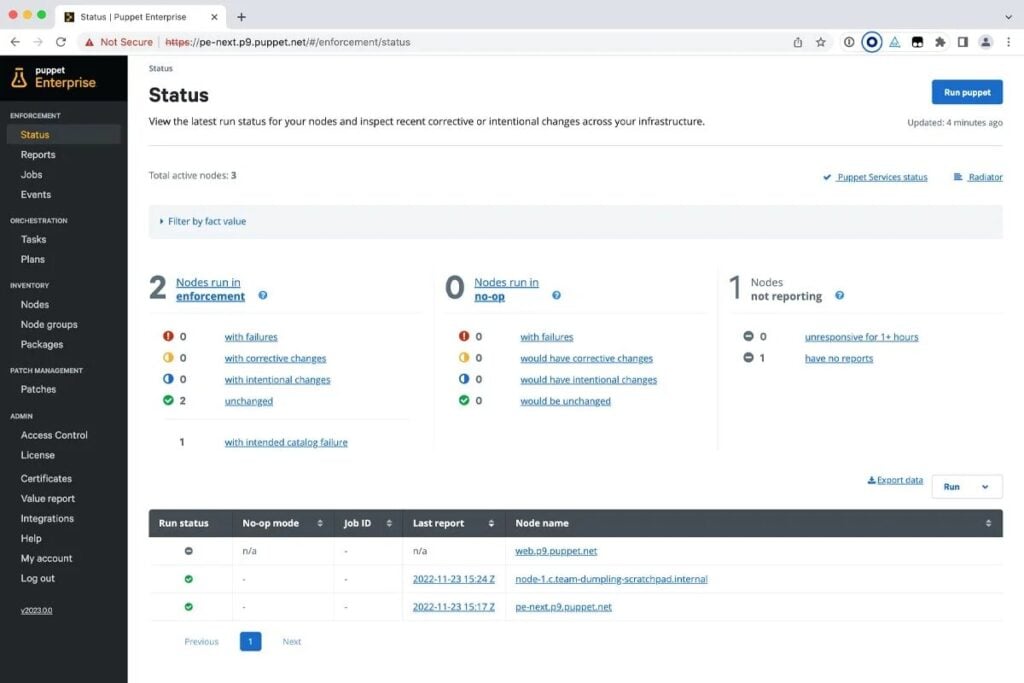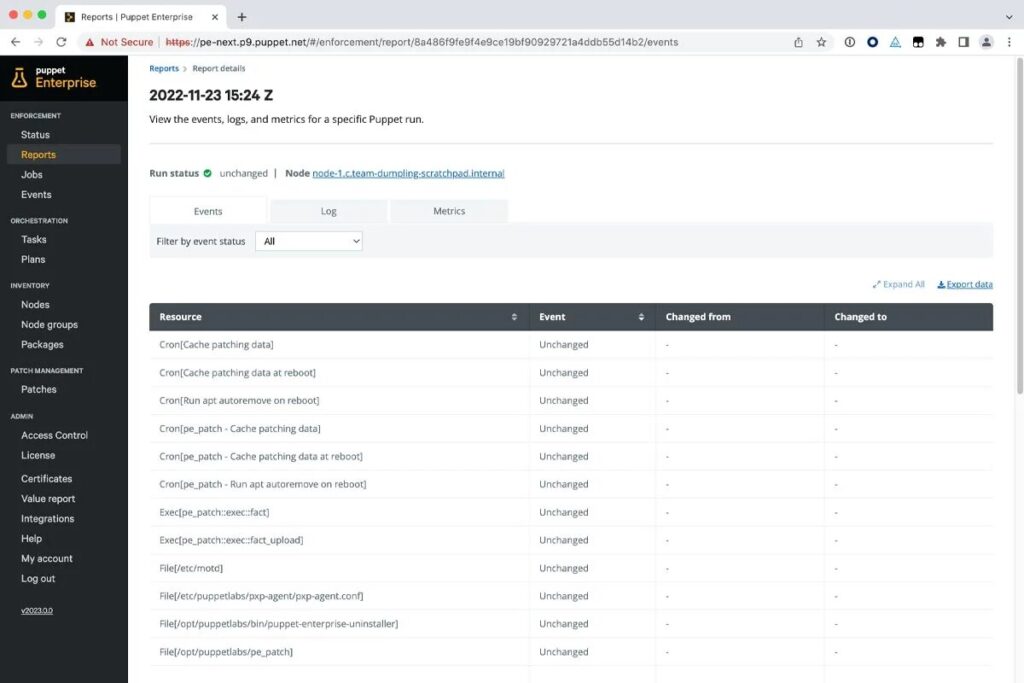With years woven into infrastructure automation software, I bring a reservoir of experience to this review of Puppet Enterprise, aimed at offering you all the information you need to gauge whether this software aligns with your needs.
My role is to illuminate the capabilities, features, and functionalities of Puppet Enterprise with transparency and depth.

Puppet Enterprise Software Product Overview
Puppet Enterprise is an open-source configuration management tool and software written in Ruby that orchestrates the automation of provisioning and configs for the entire IT infrastructure making the entire workflow smoother. Its primary users are IT professionals, system administrators, and developers looking to manage IT infrastructure.
Moreover, Puppet assists in visualizing the status of comprehensive data center orchestration, including virtualized and cloud infrastructure, and it accommodates all operating systems such as Linux, and Windows. Also, it works well with various cloud vendors such as AWS and Azure.
In fact, the tool simplifies complex network setups and ensures consistent management of the lifecycle and delivery of services, resolving the hassle of manual configuration and the risks associated with it. Furthermore, its standout features include real-time reports, desired state conflict resolution, modules, and role-based access control.
Pros
- Real-Time Reporting: Provides insights into configurations and changes, allowing users to make informed decisions.
- Desired State Conflict Resolution: Ensures configurations remain consistent, mitigating discrepancies across the infrastructure.
- Role-Based Access Control: Secures accessibility, permitting users based on roles and responsibilities.
Cons
- Learning Curve: Necessitates a grasp of its ecosystem, potentially slowing initial adaptation.
- Integration Limitations: Some users may find integrating with certain platforms to be less fluid.
- Customization Constraints: Tailoring functionalities to specific needs can be challenging.
Expert Opinion
Drawing from my extensive experience, I find Puppet Enterprise configuration management system a robust competitor in the infrastructure automation software sector. It shines in configuration management and automation but does struggle with ease of customization and integration with some platforms.
Its interface is well structured, and its functionality addresses a plethora of needs effectively such as end-to-end continuous delivery. Moreover, in terms of selection, Puppet Enterprise suits environments prioritizing configuration management and those inclined towards a comprehensive automation approach.
Puppet Enterprise Review: The Bottom Line
As a matter of fact, Puppet Enterprise distinguishes itself through its advanced configuration management, offering features like real-time reporting and role-based access control, which are pivotal for modern IT environments. Its ability to maintain a consistent state across infrastructures makes it a noteworthy choice in this domain.
Puppet Enterprise Deep Dive
Product Specifications
- Infrastructure as Code (IaC) - Yes
- Automated Configuration Management - Yes
- Compliance Management - Yes
- Scalability - Yes
- Centralized Management Dashboard - Yes
- Role-Based Access Control (RBAC) - Yes
- Real-time Analytics and Reporting - Yes
- Version Control - Yes
- Multi-Platform Support - Yes
- Disaster Recovery - Yes
- Patch Management - Yes
- Continuous Delivery & Deployment - Yes
- Multi-Cloud Support - Yes
- High Availability - Yes
- Open API for Integrations - Yes
- Orchestration - Yes
- Container Management - Yes
- Node Management - Yes
- Self-Service Portals - Yes
- Security Management - Yes
- Log Management - Yes
- Automated Provisioning - Yes
- Workflow Automation - Yes
- Custom Scripting Capabilities - Yes
- Collaboration Features - Yes
Puppet Enterprise Feature Overview
- Automated Deployment: Enables swift, efficient deployment of applications and services.
- Configuration Management: Manages and enforces configurations across the IT infrastructure.
- Multi-Platform Support: Accommodates various platforms, maximizing flexibility.
- Role-Based Access Control: Administers access meticulously, ensuring security.
- Real-Time Reporting: Delivers instant insights into changes and configurations.
- Scalability: Adapts to varying demands and scales effectively.
- Cloud Support: Supports cloud platforms, allowing versatile operations.
- Task Automation: Streamlines tasks, enhancing operational efficiency.
- API Support: Facilitates interaction with other software and tools.
- Desired State Conflict Resolution: Maintains uniformity in configurations across different nodes.
Standout Functionality
Puppet Enterprise stands out with its advanced desired state conflict resolution, ensuring uniform configurations. Furthermore, its real-time reporting empowers users with instantaneous insights, and its meticulous role-based access control fortifies security, making it distinct in the infrastructure automation software landscape.
Integrations
Puppet Enterprise integrates natively with a range of tools and offers an API to enable connectivity with other software. It provides add-ons to augment its capabilities and ensure it meets varied needs comprehensively.
Puppet Enterprise Pricing
Pricing upon request
Ease of Use
Puppet Enterprise presents an organized interface and logical navigation, though newcomers might find a bit of a learning curve as they acquaint themselves with the ecosystem and its functionalities.
Customer Support
Puppet Enterprise extends a variety of community support channels, ensuring users find help when needed. However, some users have reported occasional delays in response times, impacting the overall experience.

Puppet Enterprise Use Case
Who would be a good fit for Puppet Enterprise?
In assessing Puppet Enterprise, it seems clear that this tool finds its groove within large enterprises and IT environments where configuration management is pivotal. In fact, IT professionals, system administrators, and developers grappling with managing extensive IT infrastructures find immense value in its capabilities.
Industries steeped in technology, large-scale corporations, and sizable teams striving for consistent, secure, and streamlined IT processes gravitate toward Puppet Enterprise for its advanced features and robust functionality.
Who would be a bad fit for Puppet Enterprise?
Smaller entities or startups with modest IT infrastructure needs might not harvest the full benefits of Puppet Enterprise. Also, those who prioritize simple interfaces and easy integrations may find themselves grappling with its learning curve and integration limitations.
Moreover, companies with specific, tailored needs might stumble upon customization constraints and may find themselves better suited with more flexible, user-friendly alternatives.
Puppet Enterprise Review FAQs
Can Puppet Enterprise manage multi-platform environments?
Yes, Puppet Enterprise provides support and management for various platforms, ensuring flexibility.
Does it offer real-time reporting?
Yes, real-time reporting is one of its key features, offering immediate insights into changes and configurations.
Is it scalable to meet varying demands?
Yes, Puppet Enterprise scales effectively to meet different operational demands and needs.
Does it support cloud platforms?
Yes, it extends support to various cloud platforms, allowing versatile operations.
Is there a significant learning curve for newcomers?
Some users find that acclimating to the ecosystem and functionalities can take time.
Are there any integration limitations?
Some users have reported challenges in achieving fluid integration with certain platforms.
Is customization of functionalities feasible?
Customizing functionalities to specific needs can be challenging for some users.
Does it have role-based access control for secure accessibility?
Yes, it administers access meticulously based on roles and responsibilities, ensuring heightened security.
Alternatives to Puppet Enterprise
- Ansible: Better suited for scenarios that prioritize simplicity and ease of use in automation software.
- Chef: A preferable alternative when extensive customization and flexibility in infrastructure management are crucial.
- SaltStack: Ideal when fast, scalable, and responsive software is the priority for IT automation.
Read more about other infrastructure automation tools if you're interested in some other alternatives.
Puppet Enterprise Company Overview & History
As a matter of fact, Puppet Enterprise, at its core, specializes in IT automation software designed to manage infrastructure. It’s a tool of choice for several large-scale corporations and IT-centric industries. The company is headquartered in Portland, Oregon, and is known for its commitment to resolving the complexities inherent in IT infrastructure management.
The mission of Puppet is to eliminate soul-crushing work, and it has been noteworthy in its continual milestones to refine and enhance its offerings in the IT automation space.
Summary
All in all, as presented in this Puppet Enterprise review, Puppet Enterprise emerges as a robust and comprehensive IT automation tool ideal for large corporations and extensive IT environments. Furthermore, its features like real-time reporting, role-based access control, and desired state conflict resolution stand out in managing extensive IT infrastructures.
While it’s a treasure for those looking for advanced configuration management, smaller entities and those looking for simpler interfaces may need to weigh their options.
It’s imperative for potential users to consider their specific needs, the size of their operations, and their customization preferences before opting for Puppet Enterprise. Feel free to share your experiences or thoughts in the comment section below.
